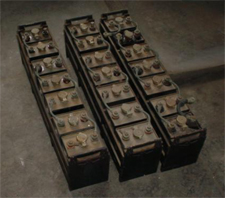Thomas Edison's Locomobile
National Park Service - Edison National Historic Site
Historic Overview

The Locomobile Company was formed in 1899 by Anzi Barber and J.B. Walker who had purchased the right to manufacture a steam car that had been developed by Frances and Freelan Stanley. The Locomobile was originally constructed with a 3.5 h.p. twin cylinder steam engine, having a 14” boiler under the driver's seat. The lightweight, wooden body was closely modeled after the horse-driven vehicles of the period, and was mounted to a tubular steel frame attached to full elliptical springs with pneumatic tires. The Edison Locomobile was modified by Thomas A. Edison who removed all steam related components. The rear of the wooden body was extended approximately 8” to accommodate the bank of nickel-iron alkaline storage batteries being developed by him to drive an electric motor that would power his experimental design.
Pre-Treatment Condition

The automobile was in fair condition; however, considered unstable due to fractures of the Edison body modifications. The original body side panels and applied faux louvers were split along the grain of the wood causing misalignment. The tubular iron chassis and leaf springs had areas of active corrosion and associated paint loss. It was estimated that 3% of the black and carmine red paint and varnish layer was missing from the vehicle. The body appears to have been partially over-painted once since its date of manufacture; perhaps during the time that modifications were made to the body. Mid to late 20th century repairs of the wooden body panels were noted as evidenced by excess adhesives believed to be modern aliphatic resin emulsion-based wood glue. All of Edison's electrical modifications, except for short lengths of wiring, had been removed from the Locomobile. Original lamps have also been removed. The runabout body retains its original Bedford cloth upholstery, having minor tears and staining of the cushion and seatback fabrics. The early tires are extremely brittle and have areas of fracturing and loss.
Treatment

The Locomobile was transported by B.R. Howard & Associates, Inc. staff to their conservation facility. The vehicle was photographically documented prior to partial disassembly of the wooden body. All structural damages were repaired using discreet wooden inserts adhered with hot hide glue and reattached using the original hardware and fasteners. The painted surfaces were cleaned using a non-aqueous based detergent solution and rinsed with mineral spirits. The areas of lifting and flaking paint were consolidated using a reversible thermoplastic resin and carefully relaxed and set down using heated micro-spatulas. Areas of paint loss were toned to blend with adjacent surfaces using a reversible resin based inpainting palette. Unpainted mechanical components were mechanically and/or chemically stabilized prior to the application of a protective lacquer coating to slow future corrosion. Textiles were dry cleaned and stabilized using nearly transparent, polyester fabric overlays and inserts slipped under the tears in the original upholstery. The rubber tires were not treated as per curatorial request. The Edison Locomobile was photo documented after treatment and transported back for exhibit at the Edison National Historic Site, West Orange, New Jersey.
Project Gallery
Click on any of the following images to enlarge
